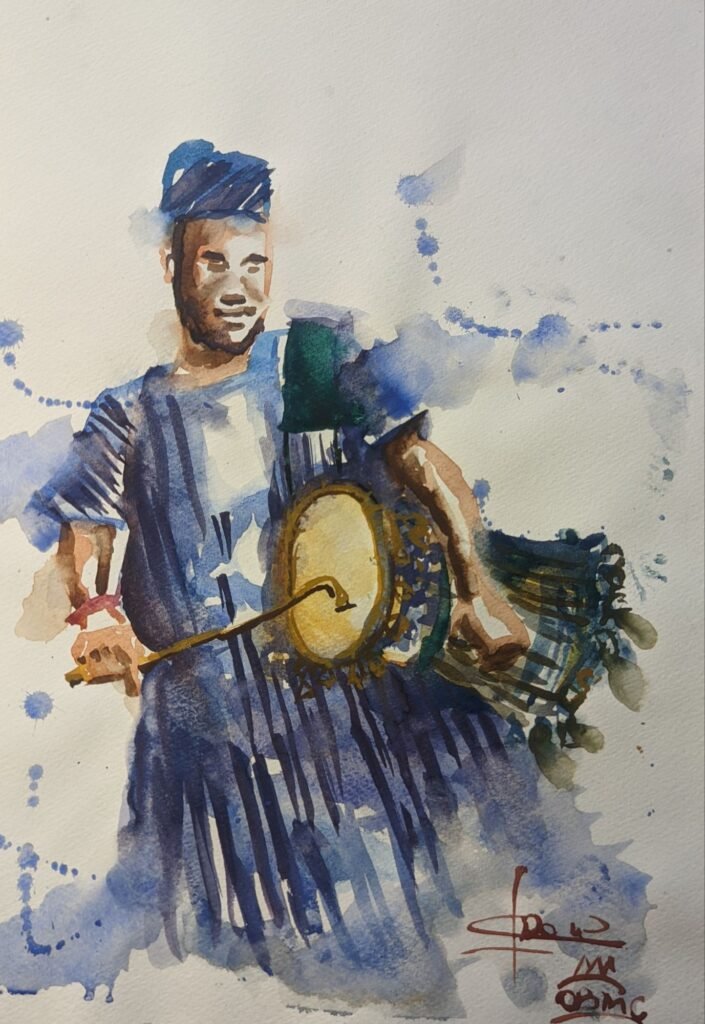
The watercolor painting “Baba Onilu,” a vibrant piece rendered on an intimate 8.3 x 11.7 inch canvas, offers us more than just a visual representation of a drummer. It serves as a portal into the rich cultural landscape surrounding the talking drum, a fascinating instrument deeply intertwined with the traditions and history of various West African cultures, particularly the Yoruba people of Nigeria. The title itself, “Baba Onilu” – the Father of the Drum – hints at the respect and significance accorded to both the instrument and its skilled players.
The artwork depicts a figure, likely a Yoruba man given the traditional attire suggested by the flowing blue garment and cap, completely engrossed in the act of playing the talking drum. The drum, rendered in warm yellows and browns, is held firmly, almost embraced, suggesting the close relationship between the drummer and his instrument. The beater, poised to strike, hints at the complex rhythms and tonal variations that this unique drum can produce.
To truly appreciate the cultural weight of “Baba Onilu,” we must understand the remarkable nature of the talking drum. Unlike fixed-pitch percussion instruments, the talking drum, known by various names across West Africa (such as dundun among the Yoruba), mimics the tones and rhythms of human speech. This remarkable ability stems from its construction: typically an hourglass-shaped drum with drumheads at both ends connected by tension cords made of leather. By squeezing these cords, the drummer can alter the pitch of the drum, effectively “speaking” or conveying messages.
The origins of the talking drum are ancient, with historical evidence suggesting its presence in West Africa for centuries. Among the Yoruba, the dundun ensemble holds a prominent place in social, religious, and political life. In pre-colonial times, these drums served as a sophisticated communication network, capable of transmitting messages across considerable distances with remarkable speed and accuracy. Skilled drummers could convey news of births, deaths, victories, and warnings, effectively acting as the “telephone” of their era.
The training to become a master talking drummer is rigorous and often begins in childhood. It requires not only exceptional dexterity and a keen ear for tonal variations but also a deep understanding of the language and its rhythmic patterns. Drummers learn a complex vocabulary of drummed phrases and proverbs, effectively becoming living libraries of their culture’s oral traditions.
In Yoruba culture, the talking drum is far more than just a means of communication. It is an integral part of ceremonies, festivals, and royal courts. The dundun ensemble provides the rhythmic backbone for dances, accompanies praise singing and storytelling, and plays a vital role in religious rituals, invoking deities and connecting with ancestral spirits. The “Baba Onilu,” the master drummer, is therefore not just a musician but a custodian of cultural knowledge, a historian, and a vital link to the community’s past and present.
The attire of the “Baba Onilu” in the painting, with its flowing indigo hues, likely signifies traditional Yoruba dress, further anchoring the artwork within this rich cultural context. The patterned cloth draped around his waist adds another layer of visual and cultural texture. His focused expression suggests the intense concentration required to articulate complex messages and rhythms through the drum.
The loose watercolor washes in the background, in shades of blue and hints of other colors, could be interpreted as the resonating sounds of the drum filling the air, or perhaps the vibrant energy of a community gathering where the drum plays a central role. The artist’s choice of watercolor, with its fluid and expressive nature, seems to echo the dynamic and communicative qualities of the talking drum itself.
“Baba Onilu” is not merely a depiction of a man playing an instrument; it is a celebration of a cultural icon. It whispers tales of ancient communication networks, of vibrant ceremonies, and of the profound connection between music, language, and identity. It invites us to listen, not just with our eyes, but with our hearts, to the rhythmic voice of the talking drum and the rich traditions it embodies. This artwork serves as a powerful reminder of the enduring cultural significance of music and the vital role of the “Baba Onilu” in preserving and transmitting the heritage of his people.
0 Comments